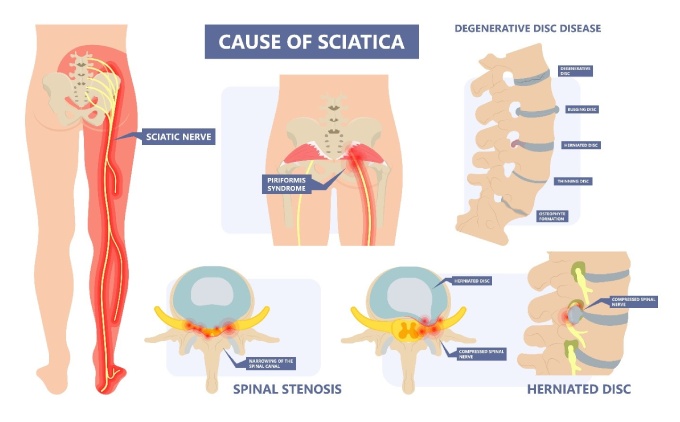
I’ve heard of the Sciatic Nerve, but what is it exactly?
The sciatic nerve is the largest and longest nerve in the human body. Basically, its job is to connect the spinal cord to the skin and muscles in thighs, lower legs, and feet. It serves dual purposes, as both a motor nerve (transmits information from the brain and spinal cord to control movement) and sensory nerve (brings information back to the brain via the spinal cord where it can be interpreted and allow us to feel pain or other sensations). The sciatic nerve begins as a network of nerves in your lower back, just above your tailbone. It travels down your buttocks, through your hips and continues down the back of your thighs to your lower knee. Here it meets with another network of nerves and makes its path down the back of your legs, until it finally ends in the sides/soles of your feet.
So, what is Sciatica?
Sciatica is when pain, numbness, and/or weakness radiates along the path of the sciatic nerve. It commonly affects the area from the buttocks to upper thigh but may also include tingling in the leg and foot. Sciatica typically involves only one side of the body.
What causes Sciatica?
Sciatic pain is caused when excessive pressure is applied to the sciatic nerve. Below are several reasons why someone may be experiencing sciatic pain:
- Herniated or Slipped Disc: Discs move and puts pressure on the nerve. (The most common cause of Sciatica)
- Spinal stenosis: Pressure is put on the nerve by the narrowing of spinal canal.
- Spondylolisthesis: Nerve is pinched by displaced vertebrae.
- Piriformis syndrome: Piriformis muscle in lower spine/upper leg tightens/spasms putting pressure on nerve.
- Spinal tumors: Tumor on/in spine presses on spinal cord/nerve root.
- Trauma: Accidents that cause a compressive force (such as motor vehicle accidents) can injure the nerve root.

How can I get relief and BACK on track?
- Pain Relievers: Over the counter pain relievers may be helpful in reducing the pain associated with sciatica. It is not a long-term solution, but may eliminate pain, inflammation and make movement more tolerable. (Please consult with your health care professional for advice on which medication is appropriate for you.)
- Ice or Heat: Cold packs can reduce inflammation and dull pain. Hot packs can help reducing muscle tightness which may be pressing down on the sciatic nerve.
- Stay off your BACKside: Avoid prolonged sitting, as this can make sciatica pain much worse.
- Move More: Regular activity, stretching and exercise (as well as maintaining a healthy weight) keeps the body flexible and strong, helping prevent sciatica before it starts.
While these treatment tips may help with acute sciatic pain, it will not cure more advanced or involved cases. We suggest you consult with a Physical Therapist when conservative treatments fail. As mentioned above, many conditions can cause sciatica. Sometimes, sciatic pain is the byproduct of another totally separate issue. A proper evaluation should be done to address your individual and unique situation. A physical therapist will use a variety of manual techniques, massage, stretches, and exercises to address your specific situation. This can give you pain relief as well as tools for future prevention.
SportsCare Physical therapists successfully help patients find relief from sciatica pain. Contact SportsCare Physical Therapy at one of our five convenient locations or schedule an appointment online today!
WE’VE GOT YOUR BACK!

